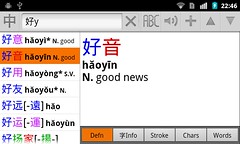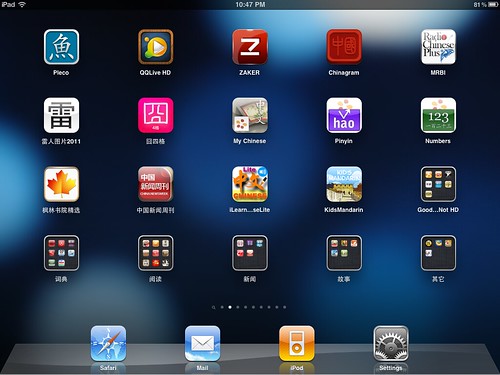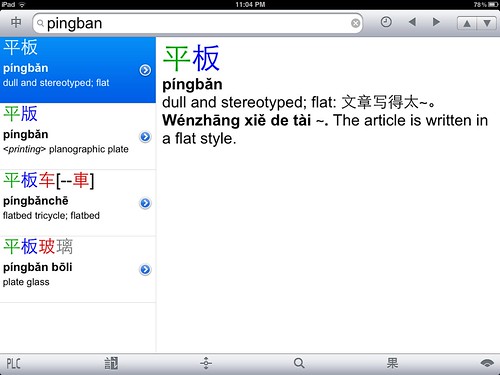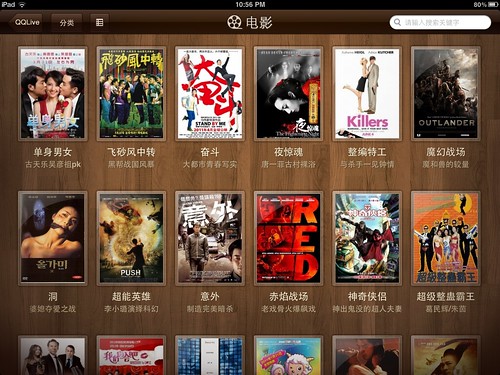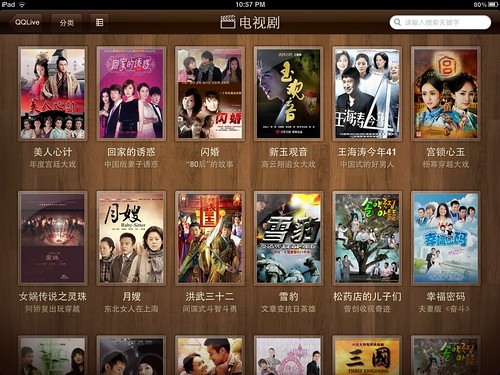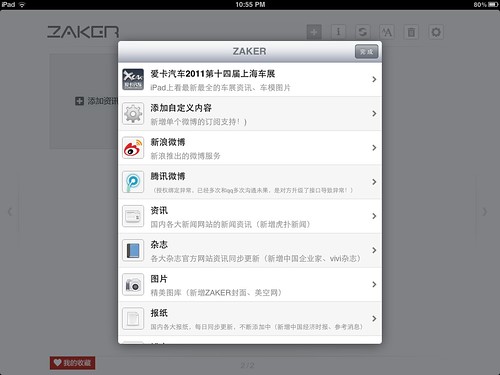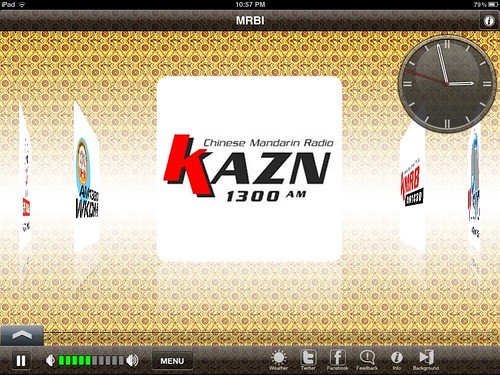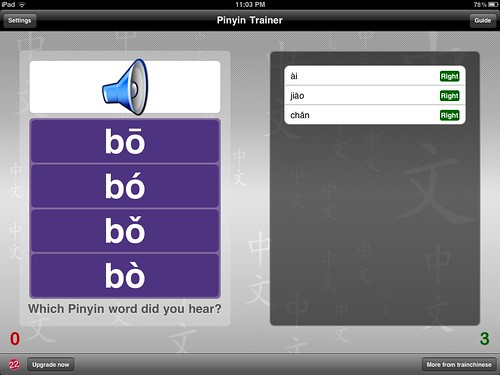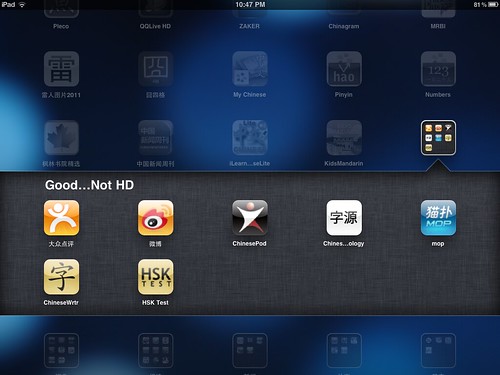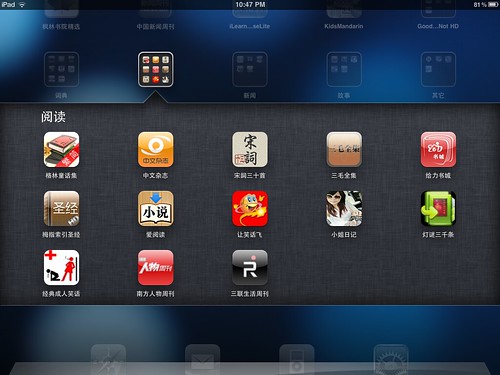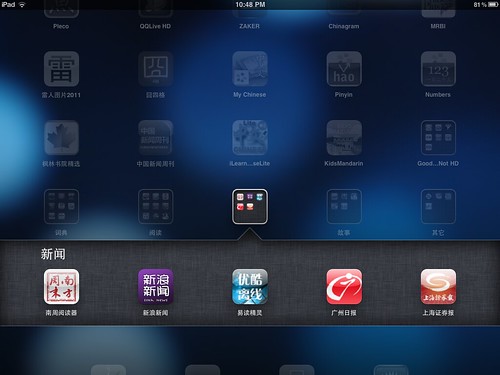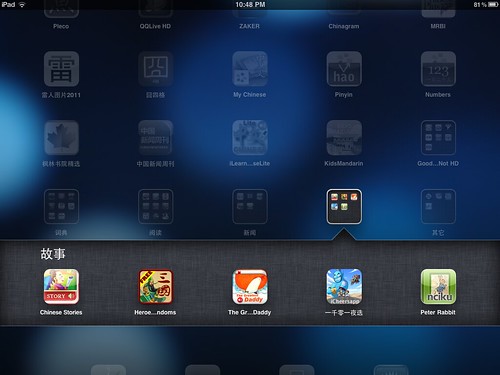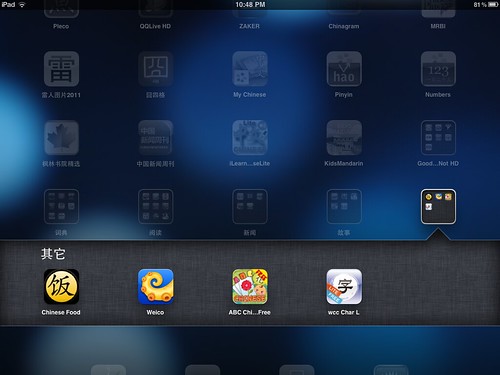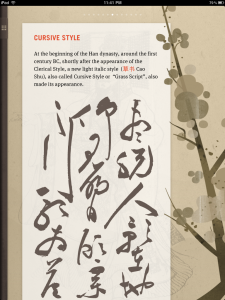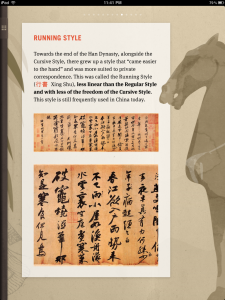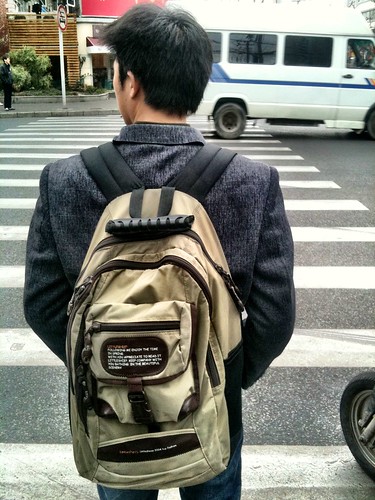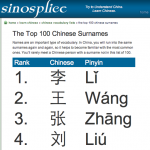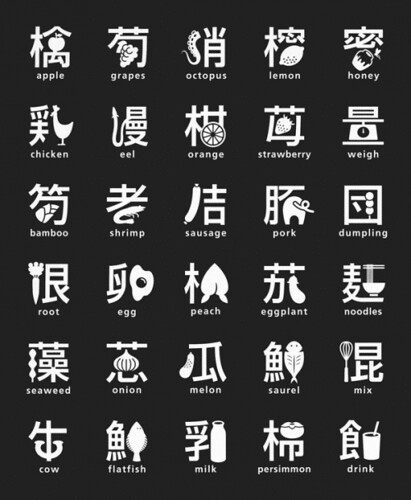07
Jun 2011China Lite
As someone who’s taken up residence in China long-term, I’ve had quite a few visitors over the years. One of the things I’ve learned is that you have to do a little “visitor profiling” if you want your guest to have a good time. Two of my own personal “case studies”:
1. My sister Grace visited me in Hangzhou in 2001. I hadn’t been in China long, and had spent a lot more time studying Chinese than trying to get comfortable. I fed Grace the 5 RMB local cafeteria food I was used to eating. When we went from Hangzhou to Beijing, I screwed up on the sleeper “ticket upgrade,” so it was 17 hours on the train in hard seats. In Beijing, we went everywhere on foot, by subway, or by bus. Poor Grace didn’t adapt too well to Chinese food; I think she might have had western food a few times, but she also shed quite a few pounds during her two weeks in China.
2. My parents visited China in 2007. We toured West Lake in Hangzhou, and went on a Bund cruise in Shanghai. We flew to Beijing and saw the sights there, assisted by a driver. We took the cable car up to the top of the Great Wall. We sampled the local food everywhere, while also getting some western food when it felt “necessary.” My parents had a very pleasant stay (but probably didn’t lose any weight).
Fortunately, by the time my parents had visited, I was a bit more compassionate about the needs of my less hardcore visitors (and had had a chance to practice this “kinder, gentler version of China” when my other sister Amy visited in 2004). Grace actually had a really good attitude about the whole ordeal, though. She felt that she had had a taste of “the real China,” and referred to what my sister Amy had experienced as “China Lite.”
I’m not trying to be a China snob here; this “China Lite” concept is useful. With my parents planning another visit, I’m working on perfecting the China Lite experience (without resorting to a tour group, if possible). While the whole “Real China” vs. “China Lite” thing is more of a continuum than a black or white issue, I’ve found it useful to compare the two.
| Real China | China Lite |
| Stay in hostels, crash at friends’ places, or even do some kind of homestay | Stay in nice hotels or service apartments |
| All Chinese food, and the more street food the better | Chinese food is fine as long as it’s not too weird; some western food (even KFC) is needed to buffer all that Chinese food |
| Baijiu (that Chinese white grain alcohol) isn’t so bad… | Tsingtao is exotic enough when it comes to alcohol |
| As much Chinese language as possible; gotta put that phrasebook to use and communicate with the locals | English if possible; translations if not |
| Travel by bus, train, and bike (with the people) is great | Airplane preferred for long trips; other forms of transportation need to provide appropriate personal space |
| Pack your own TP, and study the proper squatting position in advance | Never stray too far from a western-style toilet |
| China is big, and you don’t have much time to soak it all in, so pack that itinerary tight! | China is tiring; plan the itinerary carefully and leave sufficient down time |
| Consider the whole trip to be “off the grid” or at least “off the beaten path” with just the occasional internet cafe | Plan for internet needs, and provide a cell phone for your visitors if possible (the cost of the SIM card and phone service is negligible in China) |
Got any tips to add the the list?
Some visitors are looking for “the real China,” where others are hoping to enjoy “China Lite.” They’re both here, but it’s best to be clear on what your visitors are after.
Other takes on “China Lite”:
– China Lite in the New York Times
– China Lite on globorati
– CNYE in China Lite by Ryan McLaughlin
02
Jun 2011Pleco for Android + More Dictionaries!
Pleco has announced its long-awaited Android version (screenshots here)! This is interesting to me, because one of the major reasons I switched from an Android phone back to an iPhone was Pleco. I haven’t seen the Android version in action, but looking at the screenshots, it would seem that the iPhone is getting more Love.
From the Pleco Android beta announcement:
> This is an experimental release of our Android software; we’re making it available now for the sake of people who don’t want to wait any longer for the finished version, but there are quite a few bugs / ugly interfaces, the documentation is almost nonexistent (though you can get a pretty good idea of how it works from the iPhone version documentation), and there are also a few major features missing, so if you’re not very computer-savvy we’d recommend waiting for the finished version to be ready before downloading it, or at least waiting a few weeks to see what the feedback from other testers looks like in our discussion forums.
> In general, though, we’re very pleased with how our Android software turned out and with how much functionality we have been able to get into this first release. OCR (see below) is working beautifully on Android (both live and still, though currently only in “Lookup Words” mode), as are full-screen handwriting recognition, audio pronunciation, stroke order, and all of our add-on dictionaries. We’ve even gotten a significant portion of our document reader module working; there are no bookmarks or web browser yet, and it’ll choke if you try to load the complete text of 红楼梦, but for short-story-sized text files and snippets of text copied in from the clipboard it works quite well.
Meanwhile, the iPhone and iPad versions forge boldly ahead as well. I’m looking forward to the upcoming UI redesign. This part of the announcement was interesting:
> Central to this is a new feature we’re calling “merged multi-dictionary search”; basically, instead of typing in a word and having to flip between different dictionaries to see which matches they come up with, you’ll get all of the results from every dictionary in a single, sorted, duplicates-merged list, providing better information and doing it in a simpler way. That particular feature is actually likely to show up in an experimental form (off-by-default option) in a minor update we’ll be putting out in a few weeks; we want to make sure it’s working really well before we put it at the center of our product.
When I heard that Michael Love was looking for more dictionaries to license for Pleco, my initial reaction was, “why do you need more dictionaries? Add more dictionaries and it’s just too much hassle to navigate through them all.” And that’s a problem that this new “merged multi-dictionary search” would solve. I’m very interested to see what that ends up looking like, and how it affects the user experience.
So what are the new dictionaries being added to Pleco?
1. “the Oxford Concise English & Chinese Dictionary (now known as the Pocket Oxford Chinese Dictionary)”
2. “the Classical-Chinese-to-Modern-Chinese dictionary”
3. “the Traditional Chinese Medicine dictionary”
4. “the expanded edition of the Tuttle Chinese-English dictionary, and its companion English-Chinese title”
5. “a really nice multifunction Chengyu dictionary (detailed explanations, usage notes, antonyms/synonyms, etc)”
6. “a lovely little Chinese-Chinese student dictionary”
7. “another Chinese-Chinese student dictionary that would be our first title ever to be oriented around non-mainland users (i.e., the original print version is in traditional characters)”
Wow. And Pleco is still searching for a decent Cantonese dictionary and a character etymology dictionary to license.
31
May 201112 Angry (Chinese) Men
As a result of a rather whimsical decision made by my wife, I found myself at the Shanghai Dramatic Arts Centre for the first time last Saturday, attending a Chinese language version of the classic play Twelve Angry Men. I enjoyed it way more than I expected to.
To begin with, I was surprised by how “Chinese” the story seemed. The part about there being no air conditioning and the fan not working, and one of the guys wanting to be done with jury duty in time for a ball game (it was baseball originally, I believe), and the murder weapon being a knife rather than a gun–all just seemed to work well in the setting of Chinese society. It wasn’t until towards the end, when one of the characters started talking about how the jury’s deliberation was their duty as part of a “democratic society” and that “democracy made their country great” that the illusion sort of fell apart.
This isn’t to say that I think that modern day China is equivalent to the 1954 America in which the original story was set, but it’s interesting to me that it worked so well in this case.
I should also mention that the legal system of mainland China doesn’t make use of juries, so the “illusion” that it could be a mainland Chinese story was never very convincing to begin with. It did make for a good show, though.
I brushed up a little on my legal vocab before the play (ChinesePod has a fair amount), but it turned out that I didn’t need a whole lot. Some of the more difficult key vocabulary from the play:
– 贫民窟: slum
– 陪审团: jury
– 陪审员: juror
– 证词: testimony
– 合理的怀疑: reasonable doubt
Finally, a note on the title. This version of the play was simply titled 12个人 (12 People), but the previous movie version was called 十二怒汉 (12 Enraged Men). The classic version of that film is on Tudou under that title.
26
May 2011Puns on the Streets of Shanghai
Recently I just happened to catch this wordplay on the streets of Shanghai around me:
年轻就是不一YOUNG / 不一样. (After reading this pun, go here.)
最高G密 / 最高机密 (“top secret”); G = 鸡 = chicken. 鸡米 is a name for little chicken nuggets (often fried).
新视界 / 新世界
Not a pun; just illustrating that 新世界 is a common phrase too. This hotel is just around the corner from the eye hospital above.
碧云公寓 (traditional characters are used in the photo): not a pun either; this just amused me because we foreigners have a habit of mixing up our tones. This apartment complex could easily become “Contraception Apartment” (避孕公寓) pronounced by a careless foreigner.
24
May 2011Do I need a VPN for China?
I’ve gotten quite a few questions about VPNs lately. I also opined in a recent comment that, “There was a time when you could reasonably get by without a VPN in China. That time is over.”
For this post I’d like to return to the basic question which so many of my readers seem to have: do I need a VPN for China? Since each person’s situation is different, rather than just flat-out answering that question, I made up a little quiz to help you figure it out yourself.
Do I need a VPN for China? (a simple quiz)
1. Do you need to use Facebook at all? (This includes services like Quora that require Facebook connect, and also every little “Like” button on the internet.)
2. Do you need to be able to see YouTube (or Vimeo) videos? (Remember, it’s not just going to the YouTube site. YouTube videos are embedded in sites all over the internet.)
3. Do you need reliable access to non-YouTube Google services such as Gmail, Google Docs, Google Calendar, or even Google image search?
4. Do you need to use Twitter? (Remember, whether it’s through the site or a third party app, you’re still going to need a VPN or proxy of some kind to access Twitter.)
5. Did you find yourself uncomfortable with at least two uses of the word “need” above, telling yourself, “well, I don’t really need it…”?
Scoring
How many times did you answer “yes” to the questions in the above quiz? If the total is 1 or higher, you will likely be much happier in China if you just shelled out the cash for a decent VPN.
Note: I don’t usually publicly share which VPN I use, but if you send me a nice email, I will probably tell you.
18
May 2011Xiaoli is very weird
I just discovered these bizarre videos on Youtube called iamxiaoli. They’re supposed to be for learning Chinese, but they’re a little unorthodox, to say the least. Here are two of the ones I found more interesting:
0003 How To Say “Friend” In Chinese
0005 How To Say “What is This?” & “He Doesn’t Know” In Chinese
I’m curious how effective these videos are at teaching Chinese. Can anyone voice for having learned some words or phrases from these videos?
Anyway, Xiaoli got my attention. The (sparse) website is at iamxiaoli.com.
Not in content, obviously, but in some ways this stuff reminds me of ChinesePod in its early days, trying something new and different, unafraid to explore and experiment. I’m not surprised that this particular effort came out of Beijing.
Via Study More Chinese, via Social Mandarin.
13
May 2011So Many Flashcard Apps…
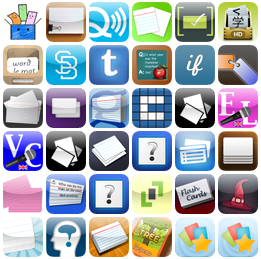
This link was too good to not post: Flashcard apps. I really dig the graphical feature display (just mouse over the icons).
Personally, though, so many choices almost makes me want to ignore all these options altogether. So far, Anki and Pleco are a good combination. I do wonder if these 100+ apps offer anything special, though.
Link via @ajatt.
10
May 2011QQ Live is Awesome
I’ve not been a fan of QQ the IM client, ever since its malware phase c. 2002. I used it to practice typing Chinese with friends online, but it forced me to use “Tencent Explorer” as my default browser as long as the software was installed. I have never forgiven Tencent for that.
Still, this QQ Live application is pretty awesome. I discovered it through its iPad version (and wrote about it in my recent iPad Apps for Chinese Study post), but have heard that there’s a desktop version for Windows that works great too. Get it!
It’s my experience that while this app doesn’t do anything that other apps don’t do, it’s especially fast (even if you’re outside China, I hear) and easy to use. Also, its limited selection is a blessing in disguise. It offers a lot of the popular TV shows and movies (including my favorite, 非诚勿扰), and saves you the trouble of having to search on Baidu video or bittorrent sites.
Remember: this is a free app with no login required. I suspect this is all a promotional trick and that we’ll all have to log in with a QQ ID just to use the program eventually, but that doesn’t mean we can’t enjoy it while it lasts!
05
May 2011iPad Apps for Chinese Study (2011)
We recently purchased an iPad 2 for AllSet Learning, and quickly set about looking for useful apps for learning Chinese. It didn’t take long for me to realize a basic truth about having an iPad: once you have an iPad, you want to run iPad apps on it, not iPhone apps. And the there are way more iPhone apps out there for learning Chinese than there are iPad apps. The purpose of this post is to call attention to the decent iPad apps out there.
I realize this post isn’t going to stay current for very long, and that’s OK. Rapid innovation is one of the things that drew me to the iOS platform in the first place. For now, though, I have my top picks for iPad apps for learning Chinese. One thing I should make clear in advance, though: many of these apps are not explicitly for learning Chinese; they’re simply apps in Chinese (good sources of more input).
Pleco
Yes, I think I’ve mentioned before that I love Pleco. It’s a great dictionary app. It also supports the iPad, while many other iPhone dictionaries don’t. I won’t say too much about Pleco here.
QQ Live HD
I must admit that I’m not a fan of the QQ IM client. But this app is great. It doesn’t require any kind of QQ login or account; it’s just a simple app for streaming Chinese movies and TV shows, and it’s fast (in Shanghai, anyway). I’ve already watched several movies on it, and while I won’t recommend any of those movies, the app does its job just fine.
Zaker
This one is an obvious Flipboard clone, but it’s a really good Flipboard clone. It’s one of those really good clones that tries to one-up the original. And, of course, it’s got tons of Chinese content ready to be added for magazine-style consumption, whether it’s Chinese news, Chinese blogs, or Weibo. It supports copy-paste, too, so you can pop over to the Pleco Pasteboard Reader when you need to.
Chinagram
I’ve reviewed this one before already: Chinagram for iPad.
Radio Chinese Plus+
This app is quite simple. It only offers three Mandarin stations and three Cantonese stations (6 total), but it works just fine.
雷人图片2011
This is just a big collection of silly photos from the internet. Some are funny; many are just bizarre.
一日一囧四格漫画
A collection of poorly drawn comics of the 冷笑话 (dumb joke) tradition. This app, like the last one, demonstrates how simple an iPad app can be.
My Chinese Library, Pinyin Trainer, and Chinese Number Trainer
I’m grouping all these apps together because they’re all by one company, called TrainChinese. While these apps aren’t revolutionary, they’re of good quality and exist in iPad versions. Sadly, not many apps for learning Chinese have met that simple requirement. They all seem to have free versions which are somewhat limited, trying to get you to pay. I recommend the pinyin trainer and number trainer to beginners.
My list of really noteworthy iPad apps for learners of Chinese ends there. There are a few others worth pointing out, though… The four others pictured but not covered are: 枫林书院精选 (an ebook reader that comes with a number of titles), 中国新闻周刊 (China Newsweek), iLearn Chinese Characters Lite, and Kids Mandarin.
These are the apps in the “Good…not HD” folder (I wish they had iPad versions):
These are the apps in the “词典” folder (iPad apps include: iCED, KTdict, eFlashChinese):
These are the apps in the “阅读” folder (iPad apps include: 格林童话集, 中文杂志, 宋词三十首, 三毛全集, 给力书城, 拇指索引圣经, 爱阅读, 让笑话飞, 小姐日记):
These are the apps in the “新闻” folder (none are iPad apps):
These are the apps in the “故事” folder (iPad apps include: Chinese Stories (really bad), Heroes of Three Kingdoms, The Greatest Daddy (English and Chinese), 一千零一夜选, nciku Peter Rabbit):
These are the apps in the “其它” folder (none are iPad apps):
I know I haven’t been exhaustive in my search for good iPad apps; I’d love to hear recommendations!
03
May 2011Chalk “Calligraphy”
I’ve seen Chinese calligraphy written in water many, many times, but this past weekend was the first time I saw it in chalk. (Maybe I just need to go to Chinese parks more?)
25
Apr 2011Readings in Ancient Chinese Poetry
Recently a comment on Sinosplice brought to my attention the fact there are many different videos of poems read in ancient Chinese (古代汉语) [more information on Wikipedia’s classical Chinese entry].
In case you’re not familiar with the concept, every language is slowly changing over time. So not only would the vocabulary and grammar of a language be different if you were able to go back in time and observe, but so would the actual pronunciation. The farther back you go, the bigger the change. As you can imagine, it’s difficult work piecing together the ancient pronunciation of a language when there are no audio records.
I can’t vouch for the accuracy of these videos (I don’t know much about ancient Chinese poetry), but they’re certainly interesting. Try showing them to a Chinese friend and see what kind of response you get. (It’s my impression that while the Chinese are well schooled in ancient poetry, they are often pretty clueless how different the ancient pronunciation of that poetry actually was. It’s not just a tone here or there!)
《關雎》上古漢語朗讀
李白 靜夜思 中古漢語朗讀
The second one is by a Chinese guy who goes by the name of biopolyhedron. He’s got a bunch of videos on both YouTube and on Youku. If you’re interested in this stuff, definitely check out his videos!
19
Apr 2011Chinagram for iPad
I recently had the opportunity to try out Chinagram, a new iPad app which introduces Chinese characters. There aren’t many Chinese-learning apps out there specifically for the iPad, so I decided to review this one.
My first impression of the app is that it is beautifully made. I guess that’s Italian design for you. The overall aesthetic is nice, and there are lots of little touches that make the app fun to use. Don’t miss the “History of Chinese Writing” section. While the information it contains is not something you can’t find on Wikipedia and many other sites, it’s definitely presented here in a way that’s enjoyable to browse. I especially liked the foreground/background faux-3D effect you get when you swipe to a new page.
After my playing with the app a little bit, the key question in my mind was, who is this app for? Is it for an advanced student? An intermediate student? A beginner? Or maybe just a casual student of Chinese? My conclusion, unsurprisingly, is that it’s for the casual student of Chinese. Sure, a beginner can get some use out of it, but since the app only covers 120+ characters, the serious student won’t be using this one for long. The strength of the app, perhaps, is its treatment of the evolution of the characters it contains. The graphics it contains go further than Wenlin, but certainly not ChineseEtymology.org (which is free). And Wenlin costs a lot more, while ChineseEtymology.org actually has an iPhone app now.
There aren’t yet many Chinese learning apps created for the iPad. Chinagram has got to be the most attractive one currently in the app store, and while it’s still $1.99 it’s a good deal for the beginner or casual learner.
14
Apr 2011The Intel Tune in Chinese
You know the little 5-note musical tune that Intel uses everywhere their logo shows up? Yeah, you know the one. It’s very easy to remember. I just became aware recently that this little musical tune has a translation into Chinese. Here it is:
So the Chinese is:
> 灯!等灯等灯!
The English translation of this would be:
> The light! Wait for the light, wait for the light!
This is amazingly appropriate, considering the “English version” of the “lyrics” would be something like:
> Dunnn…. Dun-dun dun-dun!
Not quite as articulate, I gotta say.
The whole idea of “translating a a musical tune into a spoken language” is bizaere, though.
12
Apr 2011Engrish Bookbag
I’m used to seeing Engrish on t-shirts and on signs, but this is the first time I’ve seen Engrish on a bookbag, apparently designed to be read by the people behind the wearer.
How about a closeup of that Engrish?
I have to admit, following this guy, I did enjoy the time in spring, and I appreciated to read it. I elected to skip the bathing, but this bag did bring a smile to my face.
07
Apr 2011Olay PK Ad
I think this is going to be one of Shanghai’s shortest springs ever; we’re practically going straight from winter to summer. And advertisers know it; I saw this ad for skin whitening cream on the Metro the other day:
What struck me about this ad was not the amount of English, but rather the diversity of its usage in the ad:
1. Olay: a famous brand name, untranslated. (This is kind of a ballsy move in China, but some companies do it.)
2. White Radiance: the product’s English name. This is probably mostly for aesthetic effect and symmetry of design.
3. 小S: a name. Yes, her Chinese name is 小S. It might not be her real name, but it’s her name.
4. VS: a term used pretty often in Chinese, appreciated for its simplicity and compact nature. (In Chinese, you spell it out: V-S.)
5. PK: a Chinese verb (derived from “player kill”) popular among the young internet-savvy folk, referring to some type of elimination competition.
The less interesting part is the actual content of the ad. It’s trying to get people to go to a website and vote for the star they think is whiter. Ugh.
04
Apr 2011China in the West (in a sign)
An interesting design using the characters 西 (west) and 中 (“middle”/China):
Via Sinosplice reader Érica. Photo taken in Hong Kong.
UPDATE: The original post mistakenly had 东 (east) instead of 中 in the 西. My bad!
31
Mar 2011The 100 Most Common Chinese Surnames
Names are an important type of vocabulary. Any native speaker of English can hear a name like “Stephanie” or “Tom” or “Catherine” or “John” and instantly recognize it as a name. Knowing that a word is a name can, of course, have an important impact on listening comprehension.
In Chinese, it’s not the given names that draw from a general pool of “common names;” it’s the surnames. There is a relatively small number of surnames which the vast majority of the Chinese population uses. So knowing what the most common surnames are can come in extremely handy.
I recently discovered the website MingBa.cn (名霸), and among other name-related resources, it’s got a great page on Chinese surnames, apparently from the 百家姓. It has the top 100 at the top, followed by a huge alphabetical list of Chinese surnames, including all the obscure ones (along with pinyin!).
I didn’t like how the font was pretty small, and the top 100 didn’t have pinyin, so I created a vocabulary list for the top 100 on Sinosplice: The Top 100 Chinese Surnames. Enjoy the huge font.
Related Links:
– MingBa.cn (名霸)
– Hundred Family Surnames (百家姓), on Wikipedia
– List of common Chinese surnames, on Wikipedia (lots more info, tiny font)
28
Mar 2011Japanese Food, Chinese Characters
Here’s a chart which incorporates illustrations of food into their Chinese character forms [Note: these are based on Japanese kanji, so not all apply equally to Chinese; see my notes below]:
Below are the characters involved, suped up with Sinosplice Tooltips for the readings of both the Chinese and Japanese (more notes at the bottom). I get the impression the English translations were not written by a native speaker, so I’ve added a few notes in brackets to clarify where appropriate.
| English | Japanese | Chinese (traditional) | Chinese (simplified) |
| apple | 林檎 | 蘋果 | 苹果 |
| grapes | 葡萄 | 葡萄 | 葡萄 |
| octopus | 蛸 | 章魚 | 章鱼 |
| lemon | 檸檬 | 檸檬 | 柠檬 |
| honey | 蜂蜜 | 蜂蜜 | 蜂蜜 |
| chicken | 鶏肉 | 雞肉 | 鸡肉 |
| eel | 鰻 | 鰻魚 | 鳗鱼 |
| [mandarin] orange | 蜜柑 | 橘子 | 橘子 |
| strawberry | 苺 | 草莓 | 草莓 |
| weigh | 量る | 稱 (重量) | 称 (重量) |
| bamboo [shoot] | 筍 | 筍 | 笋 |
| shrimp | 蛯 ( / 老 / 蝦) | 蝦 | 虾 |
| sausage | 腹詰 | 香腸 | 香肠 |
| pork | 豚肉 | 豬肉 | 猪肉 |
| [sweet] dumpling | 団子 | 圓子 | 圆子 |
| root [= radish] | 大根 | 蘿卜 | 萝卜 |
| egg | 卵 | 雞蛋 | 鸡蛋 |
| peach | 桃 | 桃子 | 桃子 |
| eggplant | 茄(子) | 茄子 | 茄子 |
| noodles | 麺 | 麺 | 面 |
| seaweed | 海藻 | 海藻 | 海藻 |
| onion | (玉)葱 | 洋蔥 | 洋葱 |
| melon | 瓜 | 瓜 | 瓜 |
| saurel [mackerel?] | 鯵 | 鯖魚 [?] | 鲭鱼 [?] |
| mix | 混ぜる | 攪拌 | 搅拌 |
| cow | 牛 | 牛 | 牛 |
| flatfish [flounder?] | 鰈 | 鰈魚 [?] | 鲽鱼 [?] |
| milk | 牛乳 | 牛奶 | 牛奶 |
| persimmon | 柿 | 柿子 | 柿子 |
| drink | 飲み物 | 飲料 | 饮料 |
Creating this table was a good exercise in both vocab comparison between Japanese and Chinese, and also simplified and traditional characters. A few things jumped out as I created the table above:
1. Many of the Japanese characters above are not normally written in characters (kanji). In modern Japan, many words like 林檎 (apple), 苺 (strawberry), and 蛯 (shrimp) are often just written as “りんご,” “いちご,” and “えび,” respectively, in hiragana (no characters).
2. There are words like レモン (檸檬), the word for “lemon,” which looks weird not written in katakana. And I’m not familiar with 腹詰; I’ve always encountered “ソーセージ,” which entered Japanese as a loanword from the English “sausage.”
3. 苺 means “strawberry” in Japanese, but it’s the morpheme “-berry” in Chinese, used in such words as 草莓 (strawberry), 蓝莓 (blueberry), and 黑莓 (blackberry).
4. I’m not a big fish-eater, so I’m not confident in the fish translations. Any corrections are welcome.
There’s a lot more I could say here, but unfortunately, my blogging time is limited. Comments welcome!
Related Links:
– Source: Endless Simmer (via Brad)
– More Chinese Vocabulary Lists on Sinosplice
– Learning Curves for Chinese and Japanese on Sinosplice
27
Mar 2011Da Admiral’s Mandarin Un-Learning School
I subscribe to SmartShanghai‘s email newsletter, less because I try to attend all the latest events in this city, and more because the man who writes it, “Da Admiral,” is pretty hilarious.
His latest newsletter, focused on “un-learning Chinese” definitely caught my attention:
> Whenever I’m stopped on the streets, the thing I get more than anything is, “Oh Admiral, Admiral… you’re so knowledgeable and good looking and insightful about Shanghai life and society — I bet you speak perfect Mandarin!”
> My friends, I’ll let you in on a little secret:
> The opposite couldn’t be more true! I don’t speak Chinese for shit!
> And then it occurred to me… Why don’t I take my eight-years-plus experience in not speaking Chinese and share it with others? For money?

Un-learning in action, by Cris
> So I’m opening a Mandarin Un-Learning School.
> As a sort of compliment to “Mandarin Garden” or whatever it is, I’m calling it “Da Admiral’s Mandarin Post-Apocalyptic Wasteland” and we’re accepting students at all skill levels, whether you want us to rip perfect fluency in Chinese from your brain, or even if you’re looking for something a little more part-time –maybe you’d just like to reduce your vocab a bit and un-learn a few key Chinese phrases — we can help.
> Here’s the pitch:
> “Through the sweat off his brow and sheer determination, Da Admiral has maintained a near perfect and unassailable wall of incommunicability with 99% of Chinese society. Dude is still pointing at shit on the menus like a nutsack who just got off the plane, like, yesterday.
> And now he’s willing to share his secrets with you.
> For a small enrolment fee, you’ll have access to our proven tools of whittling down knowledge of Chinese to basically nil. Whether you want to take a special, personal, one-on-one, 24 hour intensive course — basically this involves about seven pounds of weed and the Complete Filmography of Nicolas Cage — or are looking to un-learn Chinese in a group setting with our special “Dog Bloopers and Various Shit on the Internet” group classes, we’ll have you not speaking Chinese in no time.”
> Are you a Mandarin un-learner on the go? Subscribe to our special Un-ChinesePod, which is basically just me screaming nonsensical phrases in made-up French to you, intermixed with the latest news on the Batman sequel. Mind-numbing stuff. Just try to retain knowledge after a few of these.
> What I’m saying here is nothing about my time in Shanghai has been more rewarding — more spiritually fulfilling — than not learning Chinese, and I feel it’s a duty at this point to share my non-knowledge with others for money.
> I’m an educator at heart. I care about my students. They’re like my family for money. And when we’re in cabs together and I see them struggling with that last — “Zho-gw-ai” or “Yoh-gw-ai” or “Ting” or whatever the fuck it is, I don’t know, you know what I mean — I feel like my job is done.
> My job is done… and a tear comes to my eye.
I’m obligated to point out here: if you’re looking for a really good one-on-one “Mandarin Un-Un-Learning” experience in Shanghai, there’s AllSet Learning. And of course, the best Un-Un-ChinesePod is ChinesePod.
26
Mar 2011More Machine Translation Menu Fun
OK, I know, it’s been done before, and it’s just so easy. There are many menus in China with bad (and often hilarious) English translations. But even after all these years, this one stood out to me because (1) it is otherwise an extremely high quality menu, and (2) the errors are of a somewhat bizarre nature, rather than centering on horribly inappropriate mistranslations of the character 干 [more on that here and here].
Anyway, here are some samples (apologies for the quality!):
Where pathology and cuisine meet:
Halogen? (Another meaning of 卤)
A bunch of them have really weird endings (I think the machine translated names have been truncated):
This last one is my favorite, because it comes across almost poetic:
> taken meat
dishes broken
string beans
Indeed.
You can find more of the menu here.
Update:
In case you’re interested, the restaurant is called 炖品世家, or “Aristocratic Family of Soup.” (Oh yes, this is clearly a restaurant that has some fun with the English language!) The restaurant is in Shanghai, near the intersection of Kangding Road and Wanhangdu Road (康定路、万航渡路). A photo:
Also, a big thanks to Will, who introduced this resturant to me and provide the above photo and address.


